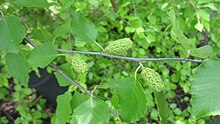river birch
Betula nigraSummary 6
Betula nigra (black birch, river birch, water birch) is a species of birch native to the Eastern United States from New Hampshire west to southern Minnesota, and south to northern Florida and west to Texas. It is one of the few heat-tolerant birches in a family of mostly cold-weather trees which do not thrive in USDA Zone 6 and up. B. nigra commonly occurs in flood plains and/or swamps.
Betula nigra 7
Cultivation and uses[edit]
While its native habitat is wet ground, it will grow on higher land, and its bark is quite distinctive, making it a favored ornamental tree for landscape use. A number of cultivars with much whiter bark than the normal wild type have been selected for garden planting, including 'Heritage' and 'Dura Heat'; these are notable as the only white-barked birches resistant to the bronze birch borerAgrilus anxius in warm areas of the southeastern United States of America.[3]
Native Americans used the boiled sap as a sweetener similar to maple syrup, and the inner bark as a survival food. It is usually too contorted and knotty to be of value as a timber tree.[3]Gallery[edit]
References[edit]
- ^ abFlora of North America: Betula nigra
- ^USDA Silvics Manual: Betula nigra
- ^ abHarlow, W. M., & Harrar, E. S. (1969). Textbook Of Dendrology 5th ed., LOC# 68-17188
- Betula nigra Diagnostic photos and information, Morton Arboretum accession 232-51-3.
- Betula nigra images at bioimages.vanderbilt.edu
Sources and Credits
- (c) Maggie, some rights reserved (CC BY-NC), http://www.flickr.com/photos/13389908@N03/1820801175/
- (c) Drew Avery, some rights reserved (CC BY), http://farm4.static.flickr.com/3600/3463692699_e1bd5f3707.jpg
- (c) John Hilty, some rights reserved (CC BY-NC), http://www.illinoiswildflowers.info/trees/photos/river_birch3.jpg
- (c) Steven J. Baskauf, some rights reserved (CC BY), http://bioimages.vanderbilt.edu/baskauf/28091
- (c) "<a href=""http://nt.ars-grin.gov/"">ARS Systematic Botany and Mycology Laboratory</a>.", some rights reserved (CC BY-NC-SA), https://plants.usda.gov/gallery/large/beni_004_lhp.jpg
- (c) Wikipedia, some rights reserved (CC BY-SA), http://en.wikipedia.org/wiki/Betula_nigra
- (c) Unknown, some rights reserved (CC BY-SA), http://eol.org/data_objects/32137745
More Info
- iNat taxon page
- Biodiversity Heritage Library
- BOLD Systems BIN search
- eFloras.org
- Flora of North America (beta)
- Global Biodiversity Information Facility (GBIF)
- Go Botany
- HOSTS - a Database of the World's Lepidopteran Hostplants
- IPNI (with links to POWO, WFO, and BHL)
- Maryland Biodiversity Project
- NatureServe Explorer 2.0
- NBN Atlas
- OregonFlora.org
- SEINet Symbiota portals
- Tropicos
- USDA PLANTS database
- VASCAN by Canadensys
- World Flora Online















